
This continueing article is based on my tour in Bolivia in July 2002. One
of the highlights on the tour was exploring the ancient site of Tiahuanaco.
Tiahuanaco (also called Tiwanaku) was obvious a major ceremonial centre
of a culture that spread across much of the region. The ancient people built a
pyramid of crude stones known as the Akapana.
Archaeological studies of the area have focused
mainly on the architecture, which consists of many perfectly carved stones fitted
together to form mighty walls and pyramids. It is estimated that
between 30,000-40,000 people were living in and around the progressive city. So far
little is known about the crafts, food storage systems, llama herds or
fishing methods.
Alan Kolata, an archaeologist, describes the center of
the city and the moat surrounding it saying it was most likely used for
ceremonial purposes, not necessarily warfare or defense. Also, because of the
yearly torrential rainfall the moats served to distribute the rain to other
drainage canals found throughout the city, which dumped it into the Tiwanaku
River.
|
Advertising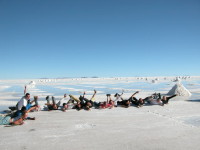 |
Contact Ranabol Expeditions
for more information and booking your adventure tour in Bolivia:
Manager: Ramiro Cortez
Soria
Address: Ranabol Expeditions, Av.
Ayacucho 112 y Heroínas, Bolivia
Phone
Office: 0591 - 4 - 4583039
Mobile 71717097
Website: www.aventurabolivia.com
E-mail: ranabolraf@hotmail.com |
Akapana is the largest pyramid and was once thought to be
a modified hill. Its base was later found to be constructed of perfectly cut and
joined facing stone blocks, a trademark of their architecture. There were also
six "T" shaped terraces
with vertical stone pillars, another distinct design. The floors were
packed dirt, most likely from the dug out moats surrounding each structure, and
the top of Akapana held a sunken court yard (Richardson 122).
The architecture displays unusual features. Many of the enormous monolithic
stone blocks seem to have been cast rather than carved.
| Photo. This statue is a bit of a mystery to
most people.
The items in each hand are not clearly identified with
any relic from this time period.
The Tiahuanaco people are thought to be a peaceful civilization that
existed before the Incas. |
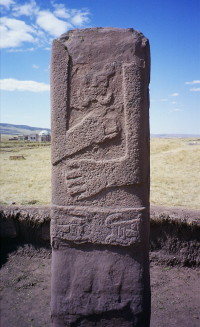 |
In the
beginning I didn`t think Tiahuanaco looked spectacle such as the ruins of Machu Picchu and
Teotihuacan. The excavated central part of the city is quite small and one can
walk across it in five minutes. Since so much has been demolished and removed over thousand of years, especially after the Spanish appeared, there
are not a large number of structures to be seen.
| Photo. Kalasayaya temple, Tiahuanaco, Bolivia. |
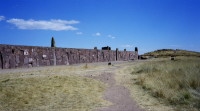 |
This lack of visual grandeur is one the reasons that Tiahuanaco has not had
extensive archaeological reconstruction like the great Maya or Inca sites. The
Bolivian government, unable to make a lot of money from tourists visiting the
unspectacular site, has sponsored only a minimum of research and reconstruction.
Additionally, because no rich burials and glittering jewels have ever been
found, most archaeologists have by passed the ruins in hopes of excavating sites
that will bring them more fame. If it were not for the pioneering work of Arthur
Posnansky, we would have little idea of the astronomical significance of the
site, or of its stunning antiquity.
Amazing discoveries
Arthur Posnansky,
a German-Bolivian scholar, has studied Tiahuanaco for almost fifty
years. Walking around the ruins, he noticed dozens of things which could not be
explained by the conventional archeological theory nor fit into its
chronological framework. All over the site were enormous blocks of stone that no
known pre-Columbian culture had the technology to fashion or transport. But even
more astonishing, the spatial arrangement of these structures - relative to one
another and to the celestial realm - indicated that their builders had a highly
sophisticated knowledge of mathematics and astronomy.
As part of Posnansky`s studies, he had conducted precise
surveys of all the principal structures of Tiahuanaco. The Kalasasaya structure, a rectangular enclosure
measuring about 450 feet by 400 feet, was delineated by a series of
vertical stone pillars (the name Kalasasaya means "the standing pillars") and had
an east-west orientation. Utilizing his measurements of the lines of sight along these
stone pillars, the orientation of the Kalasasaya, and the purposely intended deviations
from the cardinal points, Posnansky was able to show that
the alignment of the structure was based upon an astronomical principle called
the obliquity of the ecliptic.
There is no known technology in all the ancient world that could have
transported stones of such massive weight and size. The Andean people of 500 AD,
with their simple reed boats, could certainly not have moved them. Even today,
with all the modern advances in engineering and mathematics, we could not
fashion such a structure. How were these monstrous stones moved and what was
their purpose? Posnansky suggested an answer, based upon his studies of the
astronomical alignments of Tiahuanaco, but that answer is considered so
controversial, even impossible, that it has been ignored and censured by the
scientific community for fifty years.
|
Photo. The gate of sun (the author of the
article on the left hand side).
One of the astronomical alignments of Tiahuanaco? |
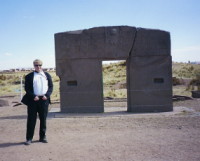 |
Among these are the ancient myths of Tiahuanaco (from
throughout the Andean region) that tell of its founding and use in a pre-flood
time; the scientific studies that prove a cataclysmic flood occurred some twelve
thousand years ago; the utensils, tools, and the fragments of human skeletons
that are mixed in with the deepest layers of the flood alluvia (indicating human
use of the site prior to the great flood); and the strange carvings of bearded,
non-Andean people that are found around the site (replete with sculptural and
iconographic detailing that is completely unique in the western hemisphere).
Posnansky, and other writers such as Graham Hancock and Zecharia Sitchin,
have suggested that these findings and the astronomical alignments of the site,
strongly point to the likelihood that the original Tiahuanaco civilization
flourished many thousands of years before the period assumed by conventional
archaeologists. Rather than rising and falling during the two millennia around
the time of Christ, Tiahuanaco may have existed during the vastly older time of
the last Ice Age, some 15,000 to 20,000 years ago. The implications of this are
truly stunning. Tiahuanaco may be (along with Teotihuacan in Mexico, Baalbeck in
Lebanon, and the Great Pyramid in Egypt) a surviving fragment of a long lost
civilization.
Who were the people of this lost
civilization, and where was it located?
To find more out about
the mysteries connected to the historical site, you can read Hancock's
fascinating book, "Fingerprints of the Gods". In support of his radical ideas
concerning the great antiquity of Tiahuanaco, Hancock gives startling proof that
the coast line of South America was mapped in extraordinarily accurate detail
long before that continent was "discovered" by Europeans.
Maps such as Piri Reis map of 1513 and the Oronteus Finaeus map of 1531,
depict the coastline of southern South America and - on the same map -
accurately show the subglacial topography of nearby Antarctica beneath its great
layer of ice. (Both these maps have notes on their borders saying they were
copied from much earlier sources.) Modern-day geological studies have confirmed
the relatively young age of the Antarctica ice, with the deepest layers being no
more than 8000 years old.
Simply explained this means that
some unknown civilization had explored and precisely mapped the then ice-free continent of Antarctica thousands of years before
it was first sighted by Europeans in 1818. Could it be
possible that people living for so long ago have been
Stein Morten Lund, 26 June 2004
Additional information
Click on the links below for more information
about ancient sites in Bolivia:
www.crystalinks.com/tiahuanaco.html
www.sacredsites.com/pilgrim/3/oct7.html
Presentation
of our partner in Bolivia (sponsored presentation and link):
****************************************************************************************************************
Ranabol Expeditions, Boliva - taking you into
unexplored areas
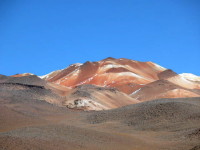 The company is a pioneer in
expeditions and unique adventures in Bolivia. It
has specialised on trekking tours to untouched places in high mountains and
tropical jungles. Some parts are still unexplored in Bolivia. The company`s
guides know well areas as Incallajta, Toro Toro, Samaipata, Tunari,
Chapare, Villa Tunari, Isiboro Sécure, Parque Amboró, Incachaca and many other
places.
The company is a pioneer in
expeditions and unique adventures in Bolivia. It
has specialised on trekking tours to untouched places in high mountains and
tropical jungles. Some parts are still unexplored in Bolivia. The company`s
guides know well areas as Incallajta, Toro Toro, Samaipata, Tunari,
Chapare, Villa Tunari, Isiboro Sécure, Parque Amboró, Incachaca and many other
places.
Ranabol arranges
expeditions to the Devil's Canyon where you will travel by
canoe on the Grande
River. On these
tours there will be great opportunities to visit archaeological places (Inca
sites etc), watch huge dinosaur prints, study cave
paintings, admire hot springs and canyons with vertical walls.
You can also
observe a unique wildlife in the area as condors, elks, deer, and also for
fishing so you can make your own food in the wilderness. Several other animals species can be found in areas around as
the endemic and endangered red frontered macaw, the andean cat, mountain lions,
parakeets, and many species of songbirds.
Ranabol take you
to unique places where you can experience the rich culture in the country.
Bolivian culture has many Inca and other Indian influences in religion, music
and clothing. The most well known fiesta is the UNESCO heritage "El carnaval de
Oruro". Bolivia has long been inhabited by advanced cultures, the most important
being the civilization of Tiahuanaco. The country is full of ancient mysteries
waiting for being solved, and exploring this important Pre-Columbian
archaeological site, is something that really makes you excited. The ruins of
the Tiahuanaco are on the eastern shore of Lake Titicaca, about 72 km (44 miles)
west of Bolivia's capital La Paz.
 Going by Ranabol you can also
experience Bolivia's many great natural wonders. One of the greatest is Lake
Titicaca (Spanish: Lago Titicaca), which is South America's largest lake and,
considered to be the highest navigable lake in the world. Another great wonder
is the Salar de Uyuni, which is the world's largest salt flat. Located 3650
meter high, Salar de Uyuni sits in the Departmento of Potosí in southwest
Bolivia near the crest of the Andes. It's now a centre for salt extraction and
processing in Colchani; Ojos del Salar. In some areas in the salt flat, cold
underground water rises to the surface and bubbles up through the salt layer,
creating unusual shapes from the eruptions of the salt. Isla del Pescado is a
hilly outpost covered with cactuses and surrounded by a flat, white sea
hexagonal salt tile. Other natural wonders in Bolivia
are Volcan Tunupa, Lake Colorada, and Lake Verde.
Going by Ranabol you can also
experience Bolivia's many great natural wonders. One of the greatest is Lake
Titicaca (Spanish: Lago Titicaca), which is South America's largest lake and,
considered to be the highest navigable lake in the world. Another great wonder
is the Salar de Uyuni, which is the world's largest salt flat. Located 3650
meter high, Salar de Uyuni sits in the Departmento of Potosí in southwest
Bolivia near the crest of the Andes. It's now a centre for salt extraction and
processing in Colchani; Ojos del Salar. In some areas in the salt flat, cold
underground water rises to the surface and bubbles up through the salt layer,
creating unusual shapes from the eruptions of the salt. Isla del Pescado is a
hilly outpost covered with cactuses and surrounded by a flat, white sea
hexagonal salt tile. Other natural wonders in Bolivia
are Volcan Tunupa, Lake Colorada, and Lake Verde.
Ranabol
Expeditions also offer several challenging activities as rafting, kayaking,
trekking, rappelling, canoeing, paragliding,
mountain biking etc. Contact the company for more
information and suggestions.
Contact info:
Manager: Ramiro
Cortez Soria
Address: Ranabol
Expeditions, Av. Ayacucho 112 y
Heroínas, Bolivia
Phone Office: 0591 - 4 - 4583039
Mobile
71717097
Website:
www.aventurabolivia.com
E-mail: ranabolraf@hotmail.com
****************************************************************************************************************
Facts about Bolivia:
Formal country name: Republic of
Bolivia
Area: 1.09 million sq km
Population: 8.8 million
People: 30%
Quechua Indian, 25% mestizo, 30% Aymará Indian, approx 15% European (principally
Spanish)
Language: Aymara, Quechua, Spanish
Religion: 95% Roman Catholic,
Protestant (Evangelical Methodist)
Government: republic
For further reading about the ancient mysteries:
FINGERPRINTS OF THE GODS by Graham Hancock
In this book Hancock deftly sets forth
tantalizing evidence to suggest the past existence of a long lost, long
forgotten civilization which might have had more influence on ancient history
than previously imagined. It is generally believed that the oldest human
civilizations developed around the Nile River or the Tigris-Euphrates Rivers and
are about 5000 years old.
Hancock believes that a highly developed, technologically advanced
civilization flourished during the last Ice Age and was destroyed more than
12,000 years ago by the widespread climactic and geophysical changes which ended
the Ice Age. In propounding his original theories, Mr. Hancock marshals data
from diverse scientific fields such as geology, astronomy, cartography, and
mathematics, to name just a few. He also incorporates pictures and myths from
his travels to ancient ruins in Egypt, Central America, and South America.
Hancock's writing always remains accessible to the lay reader and the
book reads more like an entertaining travelogue than a pseudo-scientific tome.
The narrative is a bit desultory, at times, but since the subject matter is so
novel, one tends to plow ahead. FINGERPRINTS OF THE GODS might not always
convince the skeptical reader, but it rarely ever fails to intrigue.
In a documentery produced by Discovery, Hancock was interviewed. His theories
is very fascinating, but perphaps too fantasyful. Several critical questions
were asked in this TV programme about Hancock`s theories.
